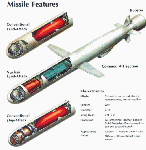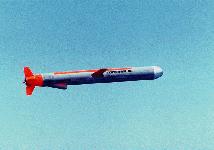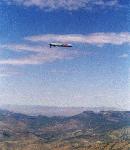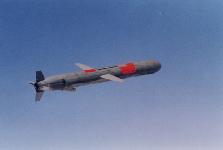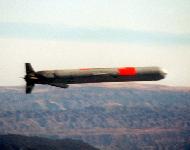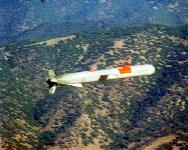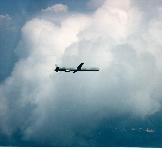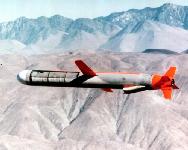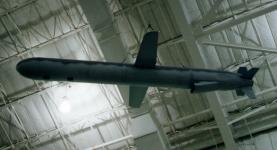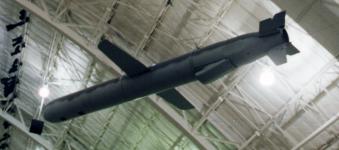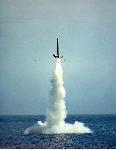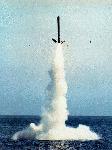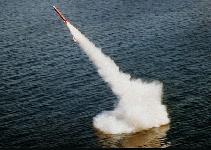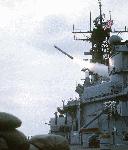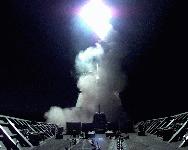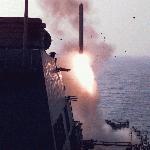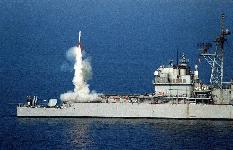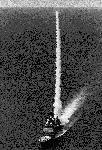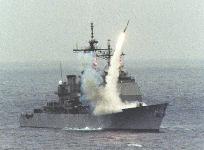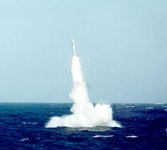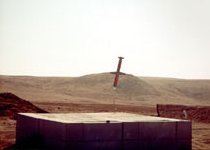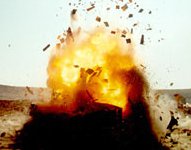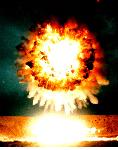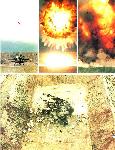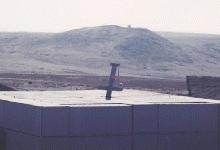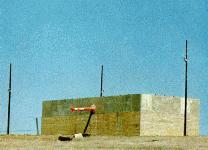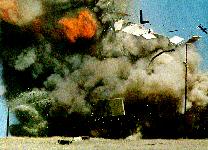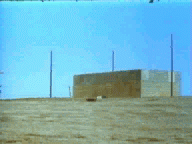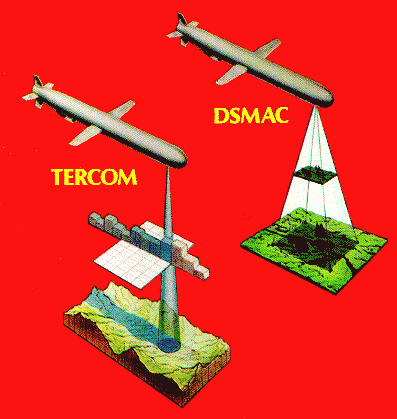



The
Tomahawk land-attack cruise missile has been used to attack a variety of fixed targets,
including air defense and communications sites, often in high-threat
environments. The land attack version of Tomahawk has
inertial and terrain contour matching (TERCOM) radar guidance. The TERCOM radar
uses a stored map reference to compare with the actual terrain
to determine the missile's position. If necessary, a course
correction is then made to place the missile on course to the
target. Terminal guidance in the target area is provided by the optical Digital Scene Matching Area
Correlation (DSMAC) system, which compares a stored image of target with the actual target image.

Tomahawk's operational environment is changing significantly. The first operational design involved global warfare using conventional Tomahawk Land Attack Missiles (TLAM) against known, fixed, non-hardened targets. The strategic assumptions underlying this environment continue to change. Tomahawk Weapon System (TWS) capability is evolving into major systems with expanding capabilities. Today, Tomahawk is able to respond to rapidly developing scenarios and attack emerging land-based targets. A more diverse threat coupled with a smaller U.S. force structure place an absolute premium on system flexibility and responsiveness.
The projected operational environment for Tomahawk is now characterized by scenarios in which the U.S. Navy will most likely be called upon to defend U.S. interests in regional conflicts, in crisis response, or to execute national policy. Tomahawk will operate from littoral seas as an integral part of joint forces.
During the critical early days of a regional conflict, Tomahawk, in conjunction with other land attack systems and tactical aircraft, denies or delays forward movement of enemy forces, neutralize the enemy's ability to conduct air operations, and suppress enemy air defenses. In addition, Tomahawk attacks high value targets such as electrical generating facilities, command and control nodes, and weapons assembly/storage facilities. Thus, making Tomahawk the weapon of choice to strike reinforced, hardened targets.
The Tomahawk Weapon System (TWS) is comprised of four major components: Tomahawk Missile, Theater Mission Planning Center (TMPC)/Afloat Planning System (APS), Tomahawk Weapon Control System (TWCS) for surface ships, and Combat Control System (CCS) for submarines.
Ships and submarines have different weapon control systems (WCSs). A vertical launching system (VLS) accommodates missile stowage and launch on ships. On all attack submarines, missiles are launched from torpedo tubes (with stowage in the torpedo room); in addition, some attack submarines have VLS located forward, external to the pressure hull, which will handle both stowage and launch.
The Fire Control Systems (FCS) on both ships and submarines perform communications management, database management, engagement planning, and launch control functions. These systems provide the interface between the missile and FCS for missile initialization and launch as well as environmental protection. The FCS supporting the ship is TWCS of ATWCS (AN/SWG-3). The FCS on submarines is the CCS MK1, CCS Mk2, or AN/BSY-1.
Unified Commanders develop contingency plans in response to developing strategic situations to achieve National Command Authority directed goals. The Unified Commander passes tasking for TLAM mission development to a Cruise Missile Support Activity (CMSA) for overland mission planning. The National Imagery and Mapping Agency (NIMA) provides the necessary databases for planning. Targets and maps are generated for TERCOM and DSMAC. Threat databases are provided for missile attrition analysis. Unified, Joint, and Battle Group (BG) Commanders direct the deployment and employment of the mission. Strike Planners select, task and coordinate TLAM strikes. The Launch platform FCS prepares and executes the TLAM mission. The launch platform launches the missile. The missile boosts and transitions to cruise flight, then navigates on the planned route. During flight, the missile will navigate using TERCOM and DSMAC and GPS (Block III). Enroute, some missiles may also execute a Precision Strike Tomahawk Mission (PST) transmitting its status back to a ground station via satellite communication. The missile executes its planned terminal maneuver and for TLAM-C hits a single aimpoint and for TLAM-D, single or multiple targets.
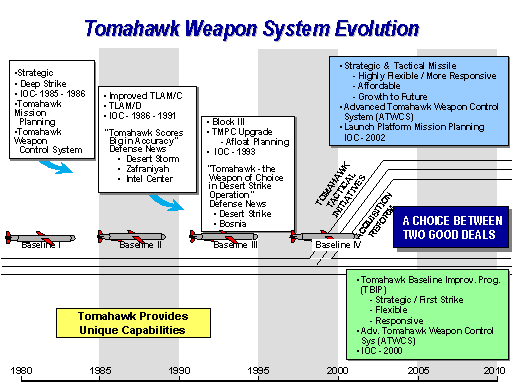
Operational evaluation to support a milestone III full rate production decision on the TOMAHAWK missile began in January 1981. This OPEVAL was conducted in six phases. The first three phases all involved testing of the submarine launched TOMAHAWK missiles. The sub launched antiship version (TASM), conventional land attack missile (TLAM/C), and nuclear land attack variant (TLAM/A) were tested from January 1981 to October 1983. The last three phases tested the ship launched variants. The ship launched variants were tested from December 1983 to March 1985. In all phases , the AUR was determined to be potentially operationally effective and potentially operationally suitable, and full rate production was recommended. In April of 1988 the OPEVAL of the conventional land attack submunitions missile (TLAM/D) was tested. The missile was determined to be potentially operationally effective and potentially operationally suitable, with limited fleet introduction recommended.
As missile improvements were made, follow on test and evaluation continued. BLK II improvements were made and tested with all variants in July 1987 through September 1987. Some of these improvements included a TASM improved sea skimming variant, an improved booster rocket, cruise missile radar altimeter, and the Digital Scene Matching Area Corellator (DSMAC) Blk II. In October of 1990, the OPEVAL of the Blk III missile began. The Blk III was the first time GPS was used to aid missile guidance. The testing was performed on both surface and subsurface units under various environmental conditions, continuing through July 1994. Both conventional variants (TLAM/C and D) were tested and determined to be operationally effective and operationally suitable, with full fleet introduction recommended.
The TOMAHAWK missile performance testing is an ongoing, five year study of TLAM performance which began in 1995. The testing is run concurrently with the Operational Test Launch (OTL) program. The objective of the program is to verify, in a statistically significant manner, that missile performance, accuracy, and reliability meet operational requirements and thresholds. The program tests approximately eight missiles each year, two TLAM/N and six TLAM/C and D missiles. The testing emphasizes operationally realistic test scenarios, including battle group operations, for missiles launched from TOMAHAWK capable Block II and Block III surface ships and submarines. Full end to end testing is completed with every mission.Tomahawk Block III Since the Gulf War, the Navy has improved its Tomahawk missile's operational responsiveness, target penetration, range, and accuracy. It has added global positioning system guidance and redesigned the warhead and engine in the missile's block III configuration that entered service in March 1993. The Tomahawk TLAM Block III system upgrade incorporated jam-resistant Global Positioning System (GPS) system receivers; provided a smaller, lighter warhead, extended range, Time of Arrival, and improved accuracy for low contrast matching of Digital Scene Matching Area Correlator. With GPS, TLAM route planning is not constrained by terrain features, and mission planning time is reduced. China Lake designed, developed, and qualified the WDU-36 warhead in 48 months to meet evolving Tomahawk requirements of insensitive munitions ordnance compliance and range enhancement, while maintaining or enhancing ordnance effectiveness. The WDU-36 uses a new warhead material based upon prior China Lake warhead technology investigations, PBXN-107 explosive, the FMU-148 fuze (developed and qualified for this application), and the BBU-47 fuze booster (developed and qualified using the new PBXN-7 explosive). Block III was first used in the September 1995 Bosnia strike (Deliberate Force) and a year later in the Iraq strike (Desert Strike).
Tomahawk Block IV Phase I The Navy’s premier strike weapon for the next generation is the Block IV Phase I Tomahawk. Current plans call for 1,253 Block IV missiles to be produced by remanufacturing currently bunkered TASMs (Tomahawk antiship variant) and upgrading Block II missiles to Block IV. Following extensive analysis of major regional conflict (MRC) Tomahawk usage and the resupply and support levels associated with it, OPNAV, in concert with fleet CINCs, developed an acquisition objective of 3,440 Block III and IV Tomahawk missiles through the completion of the Block IV program.Tomahawk Baseline Improvement Program (TBIP) The Navy will upgrade or remanufacture existing Tomahawk missiles with (1) GPS and an inertial navigation system to guide the missile throughout the mission and (2) a forward-looking terminal sensor to autonomously attack targets. These missiles are expected to enter service around 2000. This Tomahawk Baseline Improvement Program (TBIP) development provides a comprehensive baseline upgrade to the Tomahawk Weapon System to improve system flexibility, responsiveness accuracy and lethality. Essential elements of the TBIP include upgrades to the guidance, navigation, control, and mission computer systems along with the associated command and control systems and weapons control systems. TBIP will provide a single variant missile, the Tomahawk Multi-Mission Missile that is capable of attacking sea- and land-based targets in near real time. TBIP will also enhance its hard target penetrating capability beyond current weapons systems thus increasing the target set. TBIP will provide UHF SATCOM and man-in-the-loop data link to enable missile to receive in-flight targeting updates, to transfer health and status messages and to broadcast Battle Damage Indication (BDI). The Advanced Tomahawk Weapons Control System (ATWCS) and Tomahawk Baseline Improvement Program will provide a quick reaction response capability, real time target and aimpoint selection, autonomous terminal prosecution of the target and improve strike planning, coordination, mission tasking and lethality.
Tomahawk Block IV Phase II Future deep-strike requirements are in review and focus on technological advancements and cost reduction. Follow-on Tomahawk Block developments and replacement systems also are being reviewed. An antiarmor variant with a real-time targeting system for moving targets, using either Brilliant Antiarmor Technology or Search and Destroy Armor submunitions, is a possibility. Both submunition options leverage off U.S. Army developmental programs, reducing program costs. TacticalTomahawk would add the capability to reprogram the missile while in-flight to strike any of 15 preprogrammed alternate targets or redirect the missile to any Global Positioning System (GPS) target coordinates. It also would be able to loiter over a target area for some hours, and with its on-board TV camera, would allow the warfighting commanders to assess battle damage of the target, and, if necessary redirect the missile to any other target. Tactical Tomahawk would permit mission planning aboard cruisers, destroyers and attack submarines for quick reaction GPS missions. If approved by Congress, the next generation of long-range Tomahawk cruise missiles would cost less than $575,000 each, half the estimated cost of $1.1 - 1.4 million for the currently planned Block IV model. The cost savings and increased capability comes from eliminating many older internal systems and components built into the model currently in the Fleet. In addition, streamlined production techniques and modular components would combine to lower the cost. Tactical Tomahawk is expected to reach the Fleet by 2002 if the production proposal is approved by Congress. On 27 May 1999 Raytheon was awarded a $25,829,379 undefinitized cost-plus-incentive-fee/cost-plus-fixed-fee, ceiling amount contract for the modification of the Tactical Tomahawk missile to the Tactical Tomahawk Penetrator Variant configuration as part of the Second Counter-Proliferation Advanced Concept Technology Demonstration. The Tactical Tomahawk missile will be modified to incorporate the government-furnished penetrator warhead and the hard-target smart fuze. Four Tactical Tomahawk Penetrator Variant missiles will be assembled to conduct the advanced concept technology demonstration testing. Work will be performed in Tucson AZ and is expected to be completed by March 2003. Tomahawk Block V Also under consideration is a proposed Block V missile that would pioneer a new production method using modular design and construction technology to dramatically lower unit costs. Payload and guidance packages would be buyer-selectable based on use and budget.
In the early 1990s there were approximately 2,500 Tomahawks in inventory. That number was reduced to about 2,000 with the use of 330 during the 4-day bombing in Operation Desert Fox in December 1998, and the use of over 160 by the Navy in Kosovo by mid-April 1999. By one estimate, the cost of restarting the Tomahawk production line would be $40 million, and it would take 2 1/2 years before new missiles would come off that line, although the Navy is seeking $113 million to remanufacture 324 older model Tomahawks under the Tomahawk Baseline Improvement Program (TBIP).
On 30 April 1999 the US Department of Defense announced the possible sale to the Government of the United Kingdom of 30 conventionally armed TOMAHAWK BLOCK IIIC Land Attack Missiles (TLAM), containers, engineering technical assistance, spare and repair parts, and other related elements of logistics support. The estimated cost is $100 million. The additional 30 Tomahawk sea-launched cruise missiles are in addition to an original order for 65, as replacements for those fired in the Allied Force campaign by the submarine HMS Splendid. The United Kingdom needed these missiles to augment its present operational inventory and to enhance its submarine launched capability. The United Kingdom, which already has TOMAHAWK missiles in its inventory, will have no difficulty absorbing these additional missiles.
Two submarines and a number of surface ships fired Tomahawk cruise missiles during the Gulf War. According to initial US Navy reports, of 297 attempted cruise missile launches, 290 missiles fired and 242 Tomahawks hit their targets. But TLAM performance in Desert Storm was well below the impression conveyed in DOD's report to the Congress, as well as in internal DOD estimates. During Desert Storm, a TLAM mission was loaded 307 times into a particular missile for launch from a Navy ship or submarine. Of those 307, 19 experienced prelaunch problems. Ten of the 19 problems were only temporary, thus these missile were either launched at a later time or returned to inventory. Of the 288 actual launches, 6 suffered boost failures and did not transition to cruise. Despite initial strong positive claims made for TLAM performance in Desert Storm, analysis of TLAM effectiveness was complicated by problematic bomb damage assessment data. The relatively flat, featureless, desert terrain in the theater made it difficult for the Defense Mapping Agency to produce usable TERCOM ingress routes, and TLAM demonstrated limitations in range, mission planning, lethality, and effectiveness against hard targets and targets capable of mobility.
The Gulf War and subsequent contingency operations, including the September 1996 attacks on Iraqi military installations, demonstrated that long-range missiles can carry out some of the missions of strike aircraft while they reduce the risk of pilot losses and aircraft attrition.
Although the number of ships (including attack submarines) capable of firing the Tomahawk grew only slightly--from 112 to 119--between 1991 and 1996, the Navy's overall ability to fire these land-attack missiles has grown considerably. This is because a greater number of the ships capable of firing the missile are now surface ships and surface ships are able to carry more Tomahawks than submarines. As of the beginning of 1996 the US Navy had 140 Tomahawk-capable ships with 6,266 launchers), of which there are 72 SSN's (696 launchers) and 70 surface ships (5,570 launchers). There were over 4,000 Tomahawk cruise missiles in the inventory in 1996.Block III, with its improved accuracy and stand alone GPS guidance capability, was first used in the September 1995 Bosnia strike (Deliberate Force) and again in the September 1996 Iraq strike (Desert Strike). Success rates for both strikes were above 90%. In all, Tomahawks firing power shows a greater than 85% success rate
Specifications |
|
| Primary Function: |
Long-range subsonic cruise missile for
attacking land targets. |
| Contractor: |
Hughes Missile Systems Co., Tucson, Ariz. |
| Power Plant: |
Williams International F107-WR-402 cruise
turbo-fan engine; solid-fuel booster |
| Length: |
18 feet 3 inches (5.56 meters); with booster:
20 feet 6 inches (6.25 meters) |
| Weight: |
2,650 pounds (1192.5 kg); 3,200 pounds (1440 kg)
with booster |
| Diameter: |
20.4 inches (51.81 cm) |
| Wing Span: |
8 feet 9 inches (2.67 meters) |
| Range: |
Land attack, conventional warhead: 600 nautical
miles (690 statute miles, 1104 km) |
| Speed: |
Subsonic - about 550 mph (880 km/h) |
| Guidance System: |
Inertial and TERCOM |
| Warheads: |
Conventional: 1,000 pounds Bullpup, or Conventional submunitions dispenser with combined effect bomblets, or WDU-36 warhead w/ PBXN-107 explosive & FMU-148 fuze, or 200 kt. W-80 nuclear device |
| Date Deployed: |
1983 |
| Costs |
$500,000 - current production Unit Cost $1,400,000 - average unit cost (TY$) $11,210,000,000 - total program cost (TY$) |
| Total Program | 4 170 missiles |


